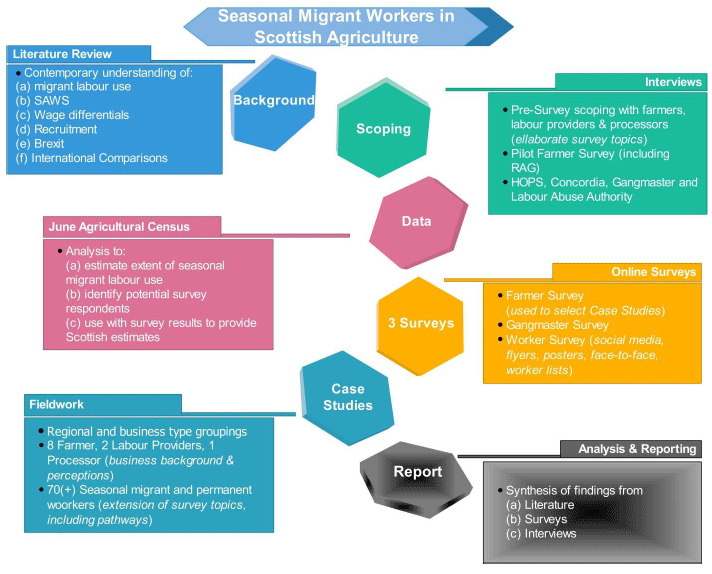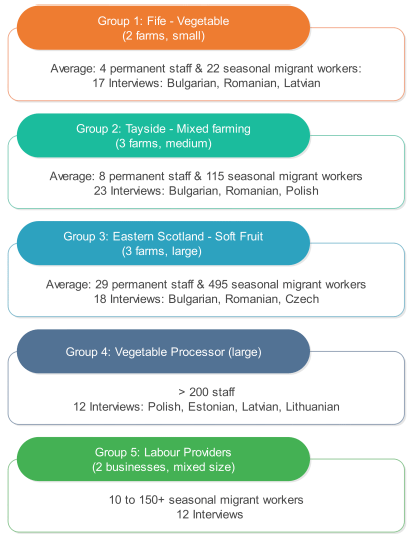Farm workers in Scottish agriculture: case studies
Case studies examining farm workers in Scottish agriculture and the international seasonal migrant labour market.
2 Methodology and case study selection
This study utilised both primary and secondary data sources and quantitative and qualitative approaches in order to elicit new information on seasonal migrant workers engaged in Scottish agriculture. The main stages of the project are summarised in Figure 1.
Figure 1: Key project stages

In order to provide a contemporary background on the topic, we conducted an extensive literature review on migrant labour use in the UK with a particular emphasis on agriculture. A wide range of academic and grey literature (including stakeholder reports, parliamentary evidence, policy literature, etc.) was used to provide an up-to-date understanding of key issues around labour use, drivers behind migration, recruitment practices, wages, etc. The literature review also provided information on migrant labour and minimum wages, etc. in other countries that enabled some international comparisons to be made.
The literature review informed the research team’s understanding of how the seasonal market operated, and some of the reported issues surrounding migrant labour use, integration, wages, etc. However, in order to extend the research team’s knowledge base beyond the literature a scoping phase was undertaken to: (i) develop greater knowledge of the complex system of regulators, intermediaries, businesses and workers; and, (ii) increase awareness of the project. Semi structured interviews were undertaken with core stakeholders ( HOPS [5] , Concordia [6] , the Gangmasters and Labour Abuse Authority ( GLAA)), farm businesses and processors. The first iteration of the surveys was discussed with key individuals and was then piloted with farm business contacts and the Research Advisory Group ( RAG).
Terminology: It was evident from the outset that the term ‘seasonal’ meant different things to different people. Some workers were classed as ‘seasonal’ despite working extensively in Scotland for long periods (9 to 11 months) before having a short break and then returning the next year. In addition, the terminology around registered ‘gangmasters’ occasionally led to confusion, in particular the grouping together of two distinct groups that are ‘labour providers’ and ‘recruitment agencies’. For that purpose when presenting our results the terms labour provider and recruitment agency are used.
As the key source of data on agricultural activity and labour use, the Scottish Government’s JAC (both 2016 and 2017 datasets) was interrogated as follows:
- Firstly, data was extracted on reported use of contract labour and migrant (non- UK) labour. This provided a baseline from which to extend and build the evidence base. Contact details of holdings that reported they had used non- UK workers in 2016, and those whose activities suggest that seasonal workers may be required (e.g. those with horticultural crops over 1 hectare) were provided by RESAS in order to target the project’s farmer survey.
- Secondly, once the farm business survey was closed, the survey responses were aligned to the appropriate business/holding (farm businesses were asked to provide their holding number or business reference number to facilitate this process) data of the 2017 JAC. This process allowed: (i) the bio-physical details of the farm to be extracted rather than extending the farmer questionnaire; and (ii) identification of farm businesses/holdings that there were non-responses (from the survey or the JAC). The JAC response data on migrant labour was then adjusted using survey data where available, with extrapolations then made for other holdings/businesses using details of the fruit and vegetables grown.
Online surveys of farm businesses, registered labour providers and farm workers were utilised in order to develop the evidence base. All surveys were sense checked with volunteer businesses contacted during the scoping phase, with additional review provided by stakeholders through the RAG. The questions were arranged around the key themes identified by the RAG and emerging from the literature.
For the farm business survey a letter was sent to all businesses/holdings that were identified through the JAC as having used non- UK workers in 2016. Additionally, letters were sent to any holding/business that may be expected to use seasonal labour for vegetable/fruit production for human consumption (through the JAC data). This resulted in 430 letters being issued. A social media campaign also took place and leaflets were distributed at agricultural shows to raise awareness of the survey and extend the invitation to anyone that had not received a participation invite letter. Additionally, stakeholders published articles that promoted the survey on websites and in newsletters. One hundred and one survey responses were received which, after removal of duplicate entries and responses that did not use seasonal labour, left 59 usable responses where seasonal migrant labour was employed directly by the business with a further 26 that used labour providers or machinery rings. These respondents represented the majority of the industry meaning a high degree of penetration from the survey. The survey can be found in Appendix 1 where it can be seen that the key themes explored related to:
- Farmer and business characteristics.
- General staffing and use of labour providers.
- Seasonal migrant worker use, origins and use throughout the year.
- Worker recruitment and retention.
- Working hours, pay and conditions.
- Accommodation provision.
- Trends in seasonal workforce.
- Brexit.
A survey of labour providers was undertaken. Some 220 letters were sent to labour providers registered (in the publicly-available GLAA register [7] ) to provide labour to the agriculture and horticulture sectors in Scotland, inviting their participation in the labour provider survey. A disappointingly low level of responses were received, although on further discussions with GLAA representatives it became apparent that the database is not updated for businesses, meaning they may have registered to supply labour in Scotland (or to agriculture) during their initial registration but have never been active in Scotland. The survey can be found in Appendix 2 where it can be seen that the key themes explored related to:
- Business characteristics and sectors workers supplied to.
- Worker recruitment and retention.
- Seasonal migrant worker use, origins and use throughout the year.
- Working hours, pay and conditions.
- Accommodation provision.
- Trends in seasonal workforce.
- Brexit.
The worker survey was more challenging to administer and target. In order to maximise the number of respondents the survey was professionally translated and made available for completion in 6 languages (English, Romanian, Czech, Bulgarian, Polish and Latvian). These languages were selected on the basis of intelligence gathered through the farm business survey. Leaflets were distributed to workers at a number of farm businesses that had agreed to provide access to their workforce. In addition, a targeted Facebook campaign was undertaken in multiple languages to encourage people that worked seasonally in agriculture and were of non- UK origin to complete the survey. In total 277 survey responses were completed (although completion rates were relatively low) and as they are self-selecting responses and were completed towards the end of the season, they likely introduce a degree of bias to the results. The survey can be found in Appendix 2 where it can be seen that the key themes explored related to:
- Personal background including country of origin.
- Agricultural work experience.
- Current agricultural work activities.
- Recruitment pathways.
- Motivations.
- Accommodation.
- Working community and wider integration.
- Positive and negative aspects of working in Scotland.
- Future work plans and Brexit.
Figure 2: Summary details of case studies

Fieldwork was undertaken in order to collect more qualitative information from businesses and workers and to further expand on points of interest that emerged from the responses to the farmer, labour provider and worker surveys. The businesses where fieldwork was undertaken were self-selecting (they offered access to their workforce and to be interviewed themselves), meaning there was an unavoidable degree of bias in the reported results. It would, however, have been unethical to try and interview workers on businesses where permission had not been granted (this was not necessarily due to secrecy, or not wanting to participate in the study, but often was due to the busy nature of the business in the middle of their harvest season). In total, interviews were undertaken with managers/owners and workers on eight farms, two labour providers and one processor. Over 80 seasonal and permanent workers were interviewed in small groups of 3 or 4 participants in order to extend the survey topics and to try and establish worker recruitment pathways in more detail. Each set of business interviews was then assembled into five case study groupings, based on size of operation; business location and the nature of the business (see Figure 2). All participants were requested to complete a consent form (see Appendix 4) and the themes discussed in worker interviews are detailed in Appendix 5. During these interviews worker profiles were developed for a few consenting workers to enable their motivations and experiences to be portrayed – these are interspersed throughout the report.
The final stage of the project was the analysis, synthesis and reporting of the findings . A deliberate attempt has been made to ensure that the report follows themes rather than methodological stages (i.e. literature review, survey results (1, 2 and 3), fieldwork) to avoid repetition. This means that the results have been analysed with these themes in mind, thereby ensuring that all the pertinent information (literature, quantitative data and qualitative findings) regarding each of the sub-topics is explored in the report.
Contact
There is a problem
Thanks for your feedback